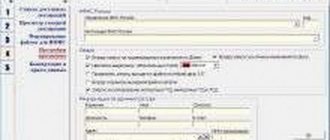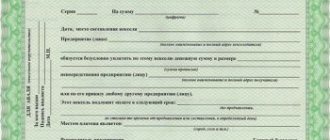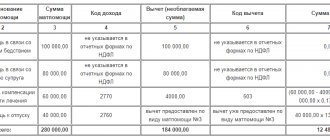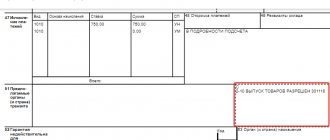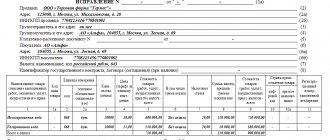Features of using a zero rate in export operations
The application of this tax rate in export operations to Kazakhstan is possible only if a complete package of documents is provided, the composition of which is given in paragraph 4 of the Protocol on the collection of indirect taxes.
If supporting documents are not provided, the standard rate of 10 or 18% is applied instead of the zero rate.
The zero rate for export operations from Russian territory also applies to the export of goods not subject to VAT.
The exporter prepares an invoice, in which he enters the rate of 0% in column 7, after which he transfers one copy to the buyer from Kazakhstan, keeps the second one for himself and enters its data in the Sales Book. The invoice is issued within 5 days from the shipping day, and the details are entered into the Sales Book in the quarter when all the documents required to justify the right to this rate are completed, executed and collected.
The 0% rate also applies to the removal of valuables for storage in warehouses in Kazakhstan with their subsequent sale by Russian sellers.
If documents are collected after 180 days
If documents are collected after the specified period, then during the period during which the documents are collected, the following actions must be performed:
- Previously accrued VAT at a rate of 10 or 18 percent is accepted for deduction (clause 10 of Article 171 of the Tax Code of the Russian Federation).
- The purchase ledger records the invoice generated when the 0 percent rate is not confirmed and is recorded in the sales ledger.
- VAT previously accepted for deduction is restored.
The declaration is completed as follows:
- line 010 of section 4 - “Operation code”;
- line 020 of section 4 - the amount of proceeds from export sales;
- line 030 of section 4 - the amount of deductions for the confirmed export transaction;
- line 040 of section 4 - the amount of tax accrued on export shipment due to the lack of documents;
- line 050 of section 4 - the amount of deduction for goods involved in export shipment.
If documents confirming the rate of 0 have been collected, but there is no right to deduction, then after such a right arises, it is necessary to fill out section 5.
The procedure for confirming the right to 0%
To apply a 0% rate to valuables exported from the Russian Federation, you need to collect a set of documentation, the list of which is strictly defined by the Protocol, and then send the prepared set to the tax office no later than the 180th day from the date of actual shipment of goods and materials. Days are taken as calendar days.
The list of documents itself is listed in clause 4 of the Protocol, and the procedure, timing and place of their transfer to the Federal Tax Service in clause 5 of the Protocol.
These statements are true for exports from Russian territory to Kazakhstan. These countries are members of the EAEU, between which an agreement has been concluded establishing special rules for interaction in trade matters. The above Protocol serves as an annex to the agreement concluded between the participants of the EAEU.
Collection of documents
The goods have traveled outside the homeland, and within 180 calendar days we need to collect a package of documents to confirm the legality of applying the 0% VAT rate.
And you shouldn’t forget about currency control. Otherwise, you can receive such a fine that the entire foreign trade transaction will be at a loss. So, for example, violation by your buyer of terms and conditions of payment threatens you with a fine of up to one lost amount (Part 4 of Article 15.25 of the Code of Administrative Offenses of the Russian Federation). It is unlikely that anyone will want to pay such a fine. Therefore, you need to carefully check the foreign buyer’s solvency or work on an advance payment basis.
By the 15th day of the month following the month of shipment/receipt of payment, you must draw up a certificate of receipt of currency or a certificate of supporting documents. Some banks provide the ability to provide such certificates using the Bank-client system. Along with this, you must provide a copy of the delivery note and a copy of the CMR, certified by authorized persons and the seal of the organization responsible for currency control (exporter).
Next, we proceed directly to collecting a package of supporting documents.
It is necessary to submit to the Federal Tax Service the documents specified in Article 165 of the Tax Code of the Russian Federation and paragraph 2 of Article 1 of the Protocol of December 11, 2009 “On the procedure for collecting indirect taxes and the mechanism for monitoring their payment when exporting and importing goods in the Customs Union”:
- A copy of the agreement (contract) with all amendments, additions and appendices to it (specifications);
- Application for import of goods and payment of indirect tax (this must be provided by your foreign buyer);
- Copies of transport documents (shipping documents: invoice, consignment note TORG-12, power of attorney to receive goods from the buyer, CMR);
- A copy of the transaction passport with all attachments (in the form of certificates of receipt of currency and certificates of supporting documents).
Together with a package of documents confirming the validity of applying the 0% rate, we submit to the tax authorities documents for VAT refund on the export transaction. That is, copies of the following incoming documents:
- Invoice and delivery note for goods, materials and services (work) from the supplier;
- Receipt order M-4 for posting goods to the warehouse;
- When shipping products of our own production for export, we present a technological map and material consumption standards;
- Calculation of VAT on indirect expenses (generated in any form).
All documents are numbered and stapled. Each copy must be certified by the signature of the manager and chief accountant, and the seal of the organization. An inventory is drawn up for the package of documents, indicating page numbers and the total number of sheets.
In addition, data on export transactions is entered into the VAT Refund program. Taxpayer". The program can be found on the official website of the Federal Tax Service https://www.nalog.ru. Its output file is also provided to the tax office along with a package of documents and a VAT return.
List of documents to justify the 0% rate
If an export transaction is carried out between two parties to the agreement on the EAEU (in this case, between Russia and Kazakhstan), then when collecting the necessary documentation, the exporter should rely on the following list: (click to expand)
- A contractual agreement concluded between participants in a supply transaction;
- An application for the import of goods and payment of indirect taxes is prepared by the buyer from Kazakhstan, submits it to his tax office, where a mark is placed on the fulfillment of the obligation to pay additional tax (or exemption from it), and then passes it to the Russian seller;
- Documents evidencing the export of valuables from Russian territory (consignment note, goods and transport bill).
The list of item 4 also indicates a bank statement confirming receipt of proceeds from the export transaction, but it should be provided if required by the tax laws of the exporter’s state. In the Russian Federation, the list of documents for using the zero rate is specified in clause 1, article 165 of the Tax Code of the Russian Federation. The list of this item does not require the mandatory submission of an extract. Therefore, Russian exporters do not need to submit it to the tax authorities in connection with the export procedure to the EAEU countries.
To this list you need to add a VAT return to be completed for the quarter when the above documentation is prepared. To fill out, take a standard declaration form intended for submitting VAT information in a standard situation.
Since the indicated declaration is submitted before the 25th day of the month following the reporting quarter, the last day for filing documents will correspond to the 25th day of the month following the quarter of the end of the allotted 180-day period.
How to pay taxes when exporting to the simplified tax system
For many entrepreneurs, when they hear the word “export,” a terrible picture of VAT refunds and tax audits immediately appears in their heads. Let's slowly get rid of these pictures and dispel the myths.
VAT does not always arise when exporting. Often taxpayers work on the simplified tax system. Basically, these are small businesses. And export transactions can arise quite often, especially within the Customs Union. Indeed, when you hear the word “export,” there is a fear that you will have to reimburse or pay VAT or undergo an in-depth inspection. But for those who pay the simplified tax system for their main activity, no VAT arises.
Let’s look at two situations for the “simplified” ones – export within the Customs Union and export to other countries. The actions of taxpayers will be completely different.
Export within the Customs Union
Let us recall that the Customs Union includes five countries: Russia, Armenia, Belarus, Kyrgyzstan and Kazakhstan. Within this Union there are no borders for the purposes of the movement of goods and customs posts at which customs declarations are checked. In other words, the procedure for document flow and trade between countries has been simplified. What is the export process within the customs union?
Step 1. An agreement is drawn up between the buyer and seller.
Step 2. An advance payment invoice is issued (mostly international trade is based on such payment terms).
Step 3. The seller undergoes currency control at his bank if the transaction size is more than 6 million rubles (limit for export contacts).
Step 4. The delivery is prepared, an international cargo waybill is drawn up (CMR - if delivery is carried out by road, if by air - this is an air waybill, if by rail - a railway waybill).
Step 5. The goods are delivered to the buyer.
Step 6. The buyer contacts his tax office and pays indirect VAT (in the amount of the tax rate that applies in his country). In Russia, this is an indirect tax declaration and notification. Submitted by the 20th day of the month following receipt of the goods.
Step 7. After paying VAT, the buyer provides the seller with a notice of payment of indirect tax. This way the seller can confirm the fact of export. However, if he is on the simplified tax system, then he does not need to do this. This step is important for those who pay VAT on their main activities, in order to pay VAT on export supplies not 20%, but 0%.
Step 8. The seller provides the customs authority with a statistical form on shipments of goods to the countries of the Customs Union by the 8th day of the month following the shipment.
It is step 8 that prevents the seller and buyer from evading paying VAT in the country where the goods are received. After all, the customs authority sends information to the tax authority of the buyer country. All interaction takes place via electronic communication channels, so it is almost impossible to hide.
Example. The Russian supplier, who pays the simplified tax system, sends a house made of laminated veneer lumber to Armenia. The cost of the house is 2 million 400 thousand rubles. In this case, it is mandatory to undergo currency control. The essence of passing currency control is to send information about the contract to the bank. The supplier issues a CMR together with the carrier and ships the cargo on July 23. The buyer receives the cargo on July 31, prepares documents and pays VAT on the delivery amount, including delivery, to the tax office by August 20. After this, it sends a notification by express mail to the supplier that VAT has been paid in the country of import. The supplier electronically submits the statistical form to the customs authority by August 8. The supplier who pays the simplified tax system does nothing else. The tax is paid based on funds received into a foreign currency account (if receipts are in foreign currency) at the Central Bank exchange rate on the date of receipt. Nothing additional is submitted to the tax office in any way.
Export outside the Customs Union (rest of the world)
Step 1. An agreement is drawn up between the buyer and seller.
Step 2. An advance payment invoice is issued (mostly international trade is based on such payment terms).
Step 3. The seller undergoes currency control at his bank if the transaction size is more than 6 million rubles.
Step 4. The delivery is prepared, an international cargo waybill is drawn up (CMR - if delivery is carried out by road, if by air - this is an air waybill, if by rail - a railway waybill).
Step 5. A customs declaration is completed with the help of customs representatives. The cost of a customs declaration is 15-20 thousand rubles.
Step 6. The goods are delivered to the buyer.
Example. The Russian supplier, who pays the simplified tax system, sends a house made of laminated veneer lumber to Iraq. The cost of the house is 2 million 400 thousand rubles. In this case, it is mandatory to undergo currency control. The essence of passing currency control is to send information about the contract to the bank. The supplier issues a CMR together with the carrier, completes a customs declaration in the shipping region and ships the cargo on July 23. The buyer receives the goods on August 1. The shipment is completed, the buyer and supplier do not need to take any further actions. Customs authorities know about exports through the customs declaration; tax authorities, together with the bank, check the fact of receipt of funds through the exchange control mechanism. The seller pays tax based on funds received into a foreign currency account at the Central Bank exchange rate on the date of receipt. Nothing additional is submitted to the tax office in any way.
It turns out that exporting from a company to the simplified tax system is much easier, because then the issue of VAT refund and mandatory tax audit does not arise. There are only restrictions on the use of the simplified tax system, including the amount of revenue of 150 million rubles. This limitation must be strictly controlled.
Nadezhda Skvortsova, financial director of the consulting company for organizing exports (FEA) EST-Group website: www.proexportrus.com phone: 8-880-551-85-82 (calls within Russia are free)
An example of determining the date for filing documents
The consignment note for export was generated on 05/04/2016.
Documents must be collected by October 31, 2016 inclusive.
The last date for submitting documents is 01/25/2017.
Method of submitting a set of documents:
- Paper (if the forms are in the form of copies, then they must be properly certified);
- Electronic via TKS (sent as scanned files).
It is better to check the available method of filing with the tax office where the documentation in question is submitted.
What to do if documents are not collected on time
Violation of the established deadline of 180 days for submitting supporting documentation entails loss of the right to a preferential rate. If the tax office does not receive the necessary documents, then the exporter will have to add a tax to the shipping cost either at a rate of 10% for goods listed in clause 2 of Article 164 of the Tax Code of the Russian Federation, or 18% for other goods.
The calculated tax is payable for the tax period in which the shipping procedure for exported valuables to Kazakhstan was carried out.
If the exporter still wishes to later exercise the right to a preferential zero rate, then he must collect the required set of documents and send them to the tax office as soon as possible. In this case, the previously paid added export tax will be offset - sent to deduction.
From 07/01/16, the procedure for deducting the added tax is carried out on the day of the subsequent calculation of VAT at a zero rate, subject to the presence on this date of the necessary supporting documents confirming the possibility of using 0%.
VAT is sent for deduction in the amount determined by the exporter's tax form, which served as the basis for the transfer of the tax amount, calculated as a result of multiplying the cost by a rate of 10 (18%). This s/f was included in the Sales Book at the time of compilation. After collecting the necessary documentation, at the time of accepting for deduction the previously paid additional tax on exports, the same tax is entered into the Purchase Book, thereby carrying out the procedure for offsetting the transferred VAT.
If documents are not collected within 180 days
If for some reason the taxpayer suddenly did not meet the deadline for collecting supporting documents and did not submit them to the Federal Tax Service, the algorithm of actions is as follows:
- It is necessary to charge VAT on sales at the appropriate rate (10 or 18 percent), drawing up the corresponding invoice in 1 copy.
- Register this invoice in an additional sheet of the sales ledger for the shipment period, reflecting the accrued VAT.
- Accept VAT, previously restored, for deduction on the date of shipment in the amount corresponding to this shipment.
The updated declaration for the shipment period is filled out as follows:
- line 010 of section 6 indicates the operation code;
- in line 020 of section 6 - revenue from the sale of export goods;
- in line 030 of section 6 - the amount of accrued VAT at a rate of 10 or 18 percent;
- in line 040 of section 6 - the amount of “input” VAT.
It should be noted that there is a court decision that speaks of the possibility of reflecting additional VAT in the declaration for the period after 180 days, and not for the period of export shipment. This position is enshrined in the resolution of the Federal Antimonopoly Service of the Moscow District dated December 22, 2010 No. KA-A40/15981-10 in case No. A40-172099/09-20-1318.
Accounting for input VAT on exports to Kazakhstan
The tax declared by suppliers of goods that are later exported to Kazakhstan is credited as a deduction, reducing the final VAT payable.
This operation is possible if the supplier has transferred a tax in which the amount of added tax appears as a separate column. For goods purchased after 07/01/16, this amount is accepted for deduction after they are accepted for accounting.
Input tax on so-called raw materials, specified in paragraph 3, paragraph 10, Article 165 of the Tax Code of the Russian Federation, is accepted for deduction on the day of calculating the base for calculating the added tax, defined in Article 167. In relation to the transactions under consideration, this moment will correspond to the last day of the quarter, when a package of documents confirming the possibility of using the zero rate has been prepared. If the documents are not collected, then the day the base is calculated will correspond to the shipment date.
The above rules prescribed for raw materials are also valid for valuables, services, works purchased and accepted for accounting before 07/01/16.
The moment of acceptance of input VAT for deduction on goods, services, works intended for export:
| Until 07/01/16 | From 01.07.16 | |
| Goods | At the time of calculating the base for the added tax:
| In the quarter of acceptance for accounting. A prerequisite is the presence of an invoice. |
| Services, works | ||
| Commodities | At the time of determining the tax base:
| |
In the quarter in which the exporter exercised the right to deduction, he has an excess of the tax added amount to be reimbursed over the amount to be paid. That is, in this situation, the tax office must reimburse the tax; the amount to be reimbursed is written down in the VAT return in section 1, field 050.
The refund procedure is standard. The tax can be offset against other federal taxes, against fines, penalties, and arrears on added tax. In this case, you can submit an application indicating how the offset should be made. If such an application is not submitted, the tax authorities will independently carry out the offset.
It is also possible to offset the refundable amount against future VAT payments.
If there is a need to receive this amount in cash, then an application must be submitted to the tax office with a corresponding request so that the tax authorities do not offset the amount of the refunded amount on their own.
VAT declaration for export to Belarus
Sales of goods to Belarus are reflected in the VAT return according to the following scheme:
What to do if documents confirming the zero rate are not collected in a timely manner? The answer to this question is in the ready-made solution from ConsultantPlus. If you do not have access to the K+ system, get a trial online access for free.
Find out which transaction codes to use to fill out a VAT return from the diagram below:
If goods are sold to a related party or a resident of an offshore zone, special codes from the specified application are applied.
The procedure for filling out individual lines of Section 4 depends on the type of product (commodity or non-commodity):
For a sample of filling out the updated VAT declaration form when exporting goods to Belarus, see ConsultantPlus, having received trial demo access to the K+ system. It's free:
The remaining sections of the declaration are completed in the usual manner.
What does an exporter need to know when exporting to Kazakhstan?
The relationship between the Russian Federation and Kazakhstan in the export procedure is regulated by the Protocol attached to the agreement on the EAEU. This Protocol contains all the nuances of the relationship.
What the exporter needs to pay attention to: (click to expand)
- It is possible to adjust the tax base for added tax, the reasons for this are determined by the Protocol - an increase or decrease in the price of exported assets, a decrease in the quantity of goods, as well as others. In this case, adjustments due to an increase in the number of exported valuables are not allowed;
- Among the documents submitted to the Federal Tax Service to justify the right to a 0% tax rate is an application for the import of goods and payment of indirect taxes. They are provided by the buyer from Kazakhstan with his tax stamp. If there are several such applications, then you do not have to submit all of them to the Russian tax office, but provide a list of them, the format of which is standard and approved by Order No. ММВ-7-15 / [email protected] dated 04/06/15, prepared and approved by the tax office of the Russian Federation.
conclusions
By shipping to the EAEU countries, in particular to Kazakhstan, Russian organizations receive great economic benefits due to the fact that the exporting taxpayer, in accordance with current legislation, does not charge VAT on this sale.
However, tax authorities are very suspicious of such shipments and thoroughly study the documents justifying the application of the rate. But still, within the EAEU, export shipments raise fewer questions from regulatory authorities than when exporting to other states, and the exporter only needs to provide correctly completed:
- Contract;
- application for the import of goods and payment of indirect taxes;
- shipping documents.
If all requirements are met, the desk audit will pass with a positive result.
If for some reason the taxpayer suddenly did not meet the deadline for collecting supporting documents and did not submit them to the Federal Tax Service, the algorithm of actions is as follows:
You can find more complete information on the topic in ConsultantPlus. Free trial access to the system for 2 days.

